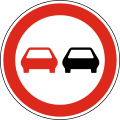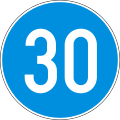
Road signs in Bulgaria were introduced by the Road Traffic Act and are regulated by:
Contents
- Warning signs
- Priority signs
- Prohibitory signs
- Mandatory signs
- Special regulations signs
- Indication signs
- Information signs
- Additional plates
- Signs not currently in use
- Unofficial road signs
- References
- External links
- Regulations for the implementation of the Road Traffic Act, adopted by a Decree of the Council of Ministers; [1] [2]
- Ordinance No. RD-02-21-1 from 23 November 2023 г. on road signaling with traffic signs, issued by the Minister of Regional Development and Public Works. [3]
Both normative documents are harmonized with the Vienna Convention on Road Signs and Signals (1968), which was ratified by Bulgaria on December 28, 1978 (This Convention was not published in the State Gazette ). [4] Bulgaria made two declarations upon signature, one reservation upon ratification and one declaration upon ratification. One reservation made upon ratification is regarding transliteration into Latin characters solely to indicate the terminal points of international routes passing through Bulgaria and places of interest to international tourism. This is because the Cyrillic script is used in the writing system of the Bulgarian language, the official language of Bulgaria.
Road signs in Bulgaria use the SNV typeface, which is also used in neighboring countries in the Balkans, such as Romania, Serbia, and North Macedonia. Inscriptions on road signs are usually written in both Bulgarian and English (Cyrillic and Latin scripts respectively), including settlement names.
Today, there are some differences between the two documents regarding road signs. The latest changes in Ordinance No. 18 were promulgated in the State Gazette No. 13, dated February 14, 2020. These changes are not reflected in the Regulations for the Implementation of the Road Traffic Act.





























































































































































































































